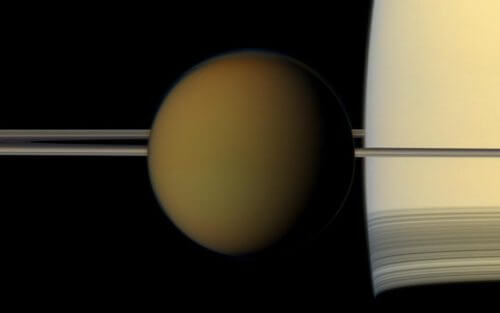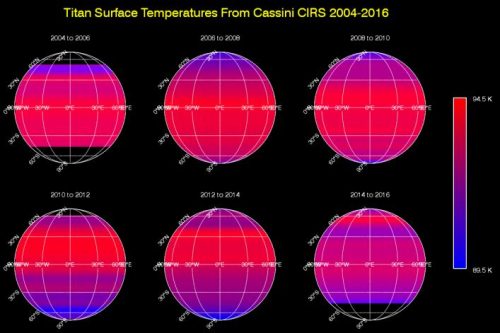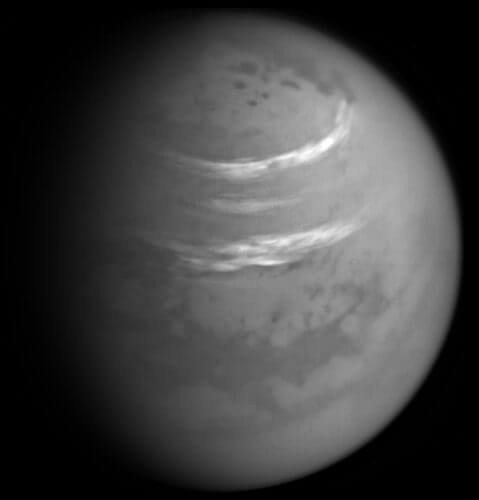New findings from the study of Saturn's largest moon - Titan, whose atmosphere contains an abundance of organic substances

atmosphere
The nitrogen and methane in the atmosphere have chemical reactions between them that create a wide variety of organic substances. The heaviest molecules of these compounds seem to reach the lunar soil. When they reach the sea, either through rain or through rivers, some of them dissolve in liquid methane, while those that do not dissolve, such as nitriles and benzene, sink to the bottom of the sea (1).
Temperatures
The sequence of maps of Titan's ground temperatures prepared based on the measurements of the Cassini between 2016 - 2004 was made at intervals of two years between one series of images. This allowed the measurement of temperatures during these years. The temperature measurement was made at a wavelength of 19 microns, since at this wavelength the atmosphere is almost entirely transparent. The temperatures were averaged around the entire moon in an east-west direction. This is in order to examine seasonal changes in the north-south direction. Black areas on the maps are those for which there is no information.
It turned out that ground temperatures vary slowly throughout Titan's seasons. Don't forget that a Titan year lasts 30 earthly years. This is the time when Saturn and its moons orbit the Sun. Therefore each season lasts 7.5 earthly years. When Cassini arrived at Saturn in 2004, the temperature in Titan's southern hemisphere was in late summer and therefore also the hottest region. Shortly after the equinox (in 2009), in 2010 the temperatures in the southern hemisphere and the northern hemisphere were the same. Similar to what was observed by the Voyager 1 spacecraft in 1980 (one Saturn year earlier). Temperatures accordingly cooled in the Southern Hemisphere and rose in the Northern Hemisphere, as winter approached. The temperature, although it varies according to latitude, is around 179.6 degrees below zero and the minimum in winter, the polar varies by 3.5 degrees (2).

The measurements did not show any significant differences in temperatures between the liquid body of the Ligeia Mare Sea and its coastline. On the other hand, there is a time gap in the warming in the North Pole as summer approaches. It is possible that the ground surrounding these lakes and seas is flooded with liquid hydrocarbons that can change their humic nature (1).
clouds
In September 2016, a new cloud was reported. The cloud was found in the stratosphere and is made of carbon and nitrogen in a molecular structure of C4N2 known as Dicyanoacetylene. The last time this type of cloud was observed was when Voyager 1 passed by Saturn. What surprised the researchers is that only 1% of this material is required for the condensation of the cloud. As in the case of Voyager 1, the stratosphere was as dry as a desert. The cloud then appeared against all expectations.
In everything related to the formation of clouds on Titan, on Earth the known process is the water cycle. On Titan, methane plays the role of water. A different type of condensation process occurs in the stratosphere. At the poles of Titan. In this case cloud layers condense as the global circulation forces warm gases to sink over the pole. So the gases condense as they pass through layers one colder than the other in the stratosphere. At the poles, the water vapor and ice reach an equilibrium point determined by the temperature and atmospheric pressure. This balance point makes it possible to calculate the amount of steam where ice is present. The process takes place in several stages. In the first stage, following chemical reactions, HC3N (Cyanoacelene) ice particles are formed. In the second stage, these particles descend into the stratosphere and are covered with a layer of hydrogen cyanide (HCN). At this stage the ice particles have a core and a shell and each of them has a different composition. At random a photon of ultraviolet radiation penetrates the frozen shell and creates a series of chemical reactions in the ice. These reactions can start either in the kernel or in the shell. In both options, hydrogen ice and dicyanoacetylene ice can be formed (see note 3).

During 2016-30.6, the Cassini spacecraft tracked cloud movement in the Northern Hemisphere. A series of photographs was taken for 29 hours, with the time interval between one photograph and another being 11 minutes. The most prominent of the clouds that were seen, the longest ones, were between latitudes 20-55 North. These clouds moved at a speed of 49 - 36 km/h. Small clouds were also found over an area of small lakes further north including a light cloud between Neagh Lacus – Punga Mare which dissipated during this series of photographs. These small cloud clusters moved at a speed of 25.2 - 7.2 km/h. This type of photography made it possible to track the dynamics of clouds during their development. The time interval between the photographs made it possible to isolate background noise such as cosmic radiation that damages the detectors, faint clouds and fog. According to Titan's climate models, a great activity of clouds was expected during the beginning of summer in the Northern Hemisphere. In practice this was not the case, which basically means that the moon's seasonal changes are still not understood (3.6).
Sources
